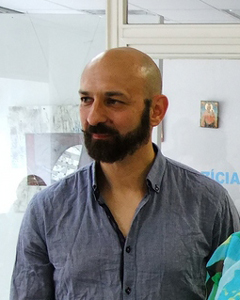There is a special spiritual bridge between Bulgaria and Slovakia related to the mission of the Holy Brothers Cyril and Methodius and their disciples. In the first half of 9 c. the two Byzantine scholars were sent to Great Moravia, part of which is present-day Slovakia, to profess Christianity in the Slavonic language. For the translation of liturgical books Constantine-Cyril the Philosopher invented the Glagolitic alphabet. Later on when Prince Boris I accepted the disciples of the holy brothers in Bulgaria and created conditions for their effective work, the Cyrillic Alphabet emerged in the School of Ohrid, an alphabet easier for writing. As to the Glagolitic one even today the elaborate graphic system of the first Slavonic alphabet has continued to inspire scholars and artists for its exploration and rethinking. It has inspired sculptor Andrey Vrabchev to recreate it into the monumental piece ABV - a  one-ton sphere of black steel with a diameter of 2.4 m. The Bulgarian artist is the only representative of the Balkans at this year's 20th edition of the Sculpture and Object Festival in Bratislava. By the end of August his concept of the Glagolitic Alphabet is to attract the interest of viewers at the park of the Presidency in the Slovak capital.
one-ton sphere of black steel with a diameter of 2.4 m. The Bulgarian artist is the only representative of the Balkans at this year's 20th edition of the Sculpture and Object Festival in Bratislava. By the end of August his concept of the Glagolitic Alphabet is to attract the interest of viewers at the park of the Presidency in the Slovak capital.
For Andrey Vrabchev recreating the graphical and symbolical system of the Glagolitic Alphabet with the language of sculpture is a personal challenge:
“The Glagolitic Script is built on very clear geometrical principles. However the invention of the alphabet proceeded based on Christian symbols and ideas”, Andrey Vrabchev told Radio Bulgaria. “There is a module figure that contains a circle, cross and triangle. Using this module all Glagolitic signs can be effectively written. It is a graphic symbol of the message - I am Jesus Christ from the beginning to end. The passionals read that Constantine-Cyril the Philosopher wrote the alphabet in one night, as the whole alphabet is contained in this single module. This geometrical principle allows a new interpretation of the alphabet in space - its presentation as a spatial issue contained in the sculpture.”
During the festival the Bulgarian Cultural Institute in Bratislava displayed other works by Andrey Vrabchev spanning cultural bridges between Bulgarians and Slovaks.
"This year Bratislava hosted s contest for the 25th anniversary since the collapse of the former regime. On this occasion I cerated a symbolical fence. As the viewer observes the sculpture, it trasforms from a fence depriving man of freedom, into a swing that denotes freedom, flight and breaking away from gravity.”
The Bulgarian sculptor has impressed Slovak audiences with a non-canonic work:
„Sacred Heart of Jesus is one of the symbols of the Catholic denomination. Fire is part of this symbol but I have replaced it with candles from Orthodox Christian churches that some people have seen as Christian unity.”

After the end of the festival in Bratislava the sculpture ABV will continue recounting the story of the Glagolitic Alphabet in Vienna where it will be on display at the Bulgarian Cultural Institute in Wittgenstein Haus.
English Daniela Konstantinova
Photos: Andrey TrebatickyThe oldest opera theatre in Bulgaria outside the capital Sofia - the Stara Zagora Opera , which is celebrating a remarkable centennial anniversary this creative season, presents a new production of Verdi's masterpiece Rigoletto on March 28 and 29...
“Standing on stage in front of so many people, with everyone looking at you and listening to the Bulgarian anthem is just a bomb of emotions,” says Dalia Rogova, who is Bulgaria’s new hope for a gold medal at the Dance World Cup, which this year will..
Renowned soloists and ensembles are special guests at the 25th edition of the European Music Festival in Sofia, which began on March 12. The festival is organized by Cantus Firmus with the support of the Sofia Municipality and the Ministry of Culture...

+359 2 9336 661
